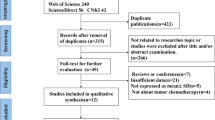Abstract
Background
We evaluated the influence of serum cystatin C (CysC) with respect to other glomerular filtration rate (GFR) markers on the treatment effect of everolimus in a phase II study in patients with metastatic renal cell carcinoma (mRCC).
Materials and methods
Outcomes were from the study’s primary analysis. GFR was calculated according to CKD-EPI-sCr equation, CKD-EPI-CysC equation and CKD-EPI-sCr-CysC equation, Modification of Diet in Renal Disease (MDRD) equation and Cockcroft–Gault (CG) equation, serum levels of creatinine (sCr) and CysC before the treatment.
Results
We observed in 56 patients analysed patients high correlation (R Spearman from ±0.69 to ±1.00; P < 0.0001) between CysC level and GFR markers: sCr, CKD-EPI-sCr, CKD-EPI-CysC, CKD-EPI-sCr-CysC, MDRD, GFR (CG) before everolimus therapy. We observed that the adverse independent predictors for everolimus therapy were increased CysC level [HR: 2.85 (95 % CI 1.34–6.05), P = 0.0065], histologic grade G1/2 [HR: 3.38 (95 % CI 1.59–7.20), P = 0.0016] and increased LDH level [HR: 5.59 (95 % CI 2.52–12.40), P < 0.0001]. Worse OS was seen in multivariate analysis in patients with increased cystatin C level before treatment [HR: 2.60 (1.03–2.60), P = 0.0428], increased corrected calcium level [HR: 2.78 (95 % CI 1.03–7.54), P = 0.0441] and increased LDH level before treatment [HR: 2.34 (95 % CI 1.11–4.97), P = 0.0262].
Conclusion
Increased serum CysC level in contrast to other studied GFR markers had predictive significance in patients with mRCC.



Similar content being viewed by others
References
Stevens LA, Coresh J, Schmid CH, Feldman HI, Froissart M, Kusek J et al (2008) Estimating GFR using serum cystatin C alone and in combination with serum creatinine: a pooled analysis of 3,418 individuals with CKD. Am J Kidney Dis Off J Natl Kidney Found 51:395–406
Inker LA, Schmid CH, Tighiouart H, Eckfeldt JH, Feldman HI, Greene T et al (2012) Estimating glomerular filtration rate from serum creatinine and cystatin C. N Engl J Med 5(367):20–29
Shlipak MG, Matsushita K, Ärnlöv J, Inker LA, Katz R, Polkinghorne KR et al (2013) Cystatin C versus creatinine in determining risk based on kidney function. N Engl J Med 5(369):932–943
Kos J, Werle B, Lah T, Brunner N (2000) Cysteine proteinases and their inhibitors in extracellular fluids: markers for diagnosis and prognosis in cancer. Int J Biol Markers 15:84–89
Nückel H, Langer C, Herget-Rosenthal S, Wichert M, Assert R, Döhner H et al (2012) Prognostic significance of serum cystatin C in multiple myeloma. Int J Hematol 95:545–550
Mori J, Tanikawa C, Funauchi Y, Lo PHY, Nakamura Y, Matsuda K (2016) Cystatin C as a p53-inducible apoptotic mediator which regulates Cathepsin L activity. Cancer Sci. doi:10.1111/cas.12881
Wegiel B, Jiborn T, Abrahamson M, Helczynski L, Otterbein L, Persson JL et al (2009) Cystatin C is downregulated in prostate cancer and modulates invasion of prostate cancer cells via MAPK/Erk and androgen receptor pathways. PLoS One 4:e7953
Bodnar L, Wcislo GB, Smoter M, Gasowska-Bodnar A, Stec R, Synowiec A et al (2010) Cystatin C as a parameter of glomerular filtration rate in patients with ovarian cancer. Kidney Blood Press Res 33:360–367
Bodnar L, Stec R, Cierniak S, Synowiec A, Wciso G, Jesiotr M et al (2015) Clinical usefulness of PI3 K/Akt/mTOR genotyping in companion with other clinical variables in metastatic renal cell carcinoma patients treated with everolimus in the second and subsequent lines. Ann Oncol. doi:10.1093/annonc/mdv166
Terpos E, Christoulas D, Kastritis E, Katodritou E, Pouli A, Michalis E et al (2013) The Chronic Kidney Disease Epidemiology Collaboration cystatin C (CKD-EPI-CysC) equation has an independent prognostic value for overall survival in newly diagnosed patients with symptomatic multiple myeloma; is it time to change from MDRD to CKD-EPI-CysC equations? Eur J Haematol 91:347–355
Sokol JP, Schiemann WP (2004) Cystatin C antagonizes transforming growth factor beta signaling in normal and cancer cells. Mol Cancer Res MCR 2:183–195
Chen Q, Fei J, Wu L, Jiang Z, Wu Y, Zheng Y et al (2011) Detection of cathepsin B, cathepsin L, cystatin C, urokinase plasminogen activator and urokinase plasminogen activator receptor in the sera of lung cancer patients. Oncol Lett 2:693–699
Kos J, Krasovec M, Cimerman N, Nielsen HJ, Christensen IJ, Brünner N (2000) Cysteine proteinase inhibitors stefin A, stefin B, and cystatin C in sera from patients with colorectal cancer: relation to prognosis. Clin Cancer Res Off J Am Assoc Cancer Res 6:505–511
Stabuc B, Vrhovec L, Stabuc-Silih M, Cizej TE (2000) Improved prediction of decreased creatinine clearance by serum cystatin C: use in cancer patients before and during chemotherapy. Clin Chem 46:193–197
Bárdi E, Bobok I, Oláh AV, Oláh E, Kappelmayer J, Kiss C (2004) Cystatin C is a suitable marker of glomerular function in children with cancer. Pediatr Nephrol Berl Ger 19:1145–1147
Summary of Recommendation Statements (2013) Kidney Int Suppl 3:5–14
European Medicines Agency—Find medicine - Afinitor [Internet] [cited 2016 Jan 23]. http://www.ema.europa.eu/ema/index.jsp?curl=pages/medicines/human/medicines/001038/human_med_000633.jsp&mid=WC0b01ac058001d124
Meinel FG, De Cecco CN, Schoepf UJ, Katzberg R (2014) Contrast-induced acute kidney injury: definition, epidemiology, and outcome. BioMed Res Int 2014:859328
Salek T, Vesely P, Bernatek J (2015) Estimated glomerular filtration rate in oncology patients before cisplatin chemotherapy. Klin Onkol Cas Ceské Slov Onkol Spolecnosti 28:273–277
Funding
This study was supported by the Polish Ministry of Science and Higher Education (grant number N N402 455139).
Author information
Authors and Affiliations
Corresponding author
Ethics declarations
Conflict of interest
The authors have declared no conflicts of interest.
Ethical approval
This study was approved by the Institutional Review Board of the Military Institute of Medicine in Warsaw (16 December 2009; No 54/WIM/2009).
Informed consent
Written informed consent was obtained from all patients.
Rights and permissions
About this article
Cite this article
Bodnar, L., Stec, R., Dzierżanowska, M. et al. Cystatin C as a predictor factor in patients with renal cell carcinoma treated by everolimus. Cancer Chemother Pharmacol 78, 295–304 (2016). https://doi.org/10.1007/s00280-016-3084-9
Received:
Accepted:
Published:
Issue Date:
DOI: https://doi.org/10.1007/s00280-016-3084-9




